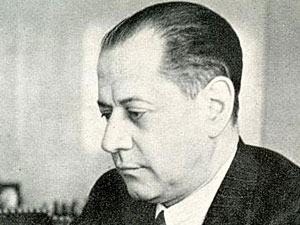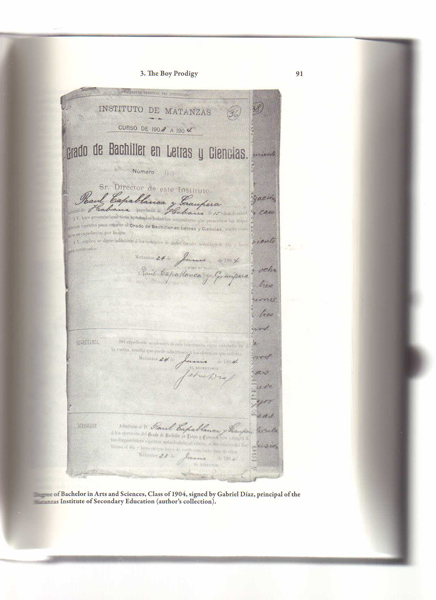


ChessBase 17 - Mega package - Edition 2024
It is the program of choice for anyone who loves the game and wants to know more about it. Start your personal success story with ChessBase and enjoy the game even more.

Miguel Angel Sanchez, José Raúl Capablanca: A Chess Biography, McFarland & Company,
Jefferson, North Carolina, USA. Foreword by Andy Soltis, 553 pages, deluxe edition hardcover.
It is a luxurious work and a true labor of love. In 18 chapters Sánchez retells Capablanca’s life, the foreword was written by the American grandmaster and renowned author Andy Soltis, while an epilogue, two appendices, notes to the chapters, an extensive bibliography and four different indices conclude the volume. The book also contains numerous illustrations, almost two hundreds annotated games, cross tables of Capablanca’s most important tournaments, a number of rare or unpublished photographs and cartoons, and even a medical study that sheds light on the health issues that plagued Capablanca at the end of his career.
In the foreword Andy Soltis asks why we continue to be fascinated by Capablanca and comes to the conclusion that "no book can answer such question. But each new book about José Raúl Capablanca makes us realize how our interest in him is repaid."
Capablanca’s Chess Biography begins with an chapter on "Havana the Eldorado of Chess" which outlines the rich chess activity in Cuba’s capital that started around 1838, includes visits by Paul Morphy in 1862 and 1864, and culminated in the World Championship matches between Steinitz and Chigorin in 1889 and in 1892.
In the following chapters the author turns to the history of Capablanca and his family, and reveals that Capablanca’s ancestors were nobles at the courts of Spain and Naples but later suffered from misfortunes. Sánchez also hints at the possibility that the man who really taught the later World Champion to play chess was the boss of Capablanca’s father, a Spanish general.
Capablanca, who was born on 19th November 1888 in Havana, was a prodigy and had a steep chess career, which Sánchez outlines in detail. In 1909 Capablanca stunned the chess world by clearly beating Frank J. Marshall, at that time one of the best players of the world in a one-sided match. Capablanca himself made his debut on the world chess scene at the tournament in San Sebastian 1911, to which he was invited by his compatriot Manuel Marquez Sterling, who, however, preferred to remain anonymous. In his book on the World Championship match between Capablanca and Alexander Alekhine in Buenos Aires 1927 Paulino Alles Monasterio had drawn attention to this mysterious benefactor, who later seems to have been forgotten.

Chapters seven and eight, “In Morphy’s Footsteps” and “A King In Waiting”, deal with Capablanca's obsession to imitate the feats of Morphy in Europe, and recapitulate Capablanca’s most important tournaments up to 1919. Among them are the famous tournament in St. Petersburg 1914, where Capablanca started sensationally well in the preliminary phase but later lost two games in a row and finished only second behind World Champion Emanuel Lasker. Also noteworthy are the Manhattan Chess Club Tournament in New York 1918, where Marshall confronted Capablanca with the famous “Marshall Gambit” which gave the Cuban a chance to show his defensive skills, and the tournament in Hastings 1919, which Capablanca won with the crushing score of 10.5/11. This chapter also contains a report about Capablanca’s trip to Argentina in 1914 where he stayed four months to give exhibitions, play simultaneous events, and appeared at conferences. However, Capablanca stayed longer than he initially intended because the outbreak of the First World War stopped him from returning to Cuba or the United States.
Chapter nine describes in detail how Capablanca won his World Championship match against Lasker in Havana 1921 and contains a remarkable number of previously unpublished documents and unknown facts about the event.
In the following chapters, “The Crowned King”, “Slipups at the Summit”, and “More Challenges, New Triumphs”, Sánchez reviews the years when Capablanca was World Champion and takes a closer at the London tournament 1922 (which Capablanca won ahead of Alekhine, Vidmar, Rubinstein, Tartakower, etc.), the very strong tournament in Moscow 1925 (where Capablanca finished third behind Bogoljubow and Lasker) and Capablanca’s triumphs in Lake Hopatcong 1926 and in New York 1927 (where he finished clear first ahead of Alekhine). The chapter also contains curious advertisements which show the Cuban promoting beer and malt, and the letters Capablanca exchanged with the organizers of the World Championship match against Alekhine 1927 in Buenos Aires.
Sánchez dedicates a whole chapter to this match, in which Capablanca suffered a surprising defeat. IN his report Sánchez relies heavily on contemporary sources, especially the newspaper Crítica where Capablanca published daily chronicles of the match. More light-hearted is a cartoon Sánchez unearthed and which mocks the many draws Alekhine and Capablanca played during their World Championship match.

Chapter fourteen, “The Eternal Challenger”, details Capablanca’s unsuccessful attempts to organize a rematch with Alekhine and throws a look at the very strong but often underestimated tournament in Berlin 1928, where Capablanca finished first ahead of Nimzowitsch, Rubinstein, Reti, Spielmann, Tartakower, and Marshall.

Chapters fifteen, sixteen, and seventeen, “Twilight Intermezzo”, “Smiling Again”, and “The Silent Killer” deal with the time when Capablanca’s career was declining slowly. He finished fourth in the Hastings tournament 1934/5 (behind Euwe, Flohr and Thomas), and in Moscow 1935 (behind Flohr, Botvinnik and Lasker), but finished second (behind Reshevsky) in Margate 1935, and first in Moscow 1936 (ahead of Botvinnik, Flohr, and Lasker). The chapter ends with the (for Capablanca) disastrous AVRO tournament in 1938, where the Cuban finished second to last on seventh place Fine, Botvinnik, Euwe, Alekhine and Reshevsky. Only Flohr finished behind. Capablanca played in this tournament even though his physician advised him not to play because Capablanca’s blood pressure was dangerously high. The physician even warned Capablanca that he "could die" when playing chess in such a condition. Another finding of great historical value is Capablanca’s previously unknown diplomatic file.
The final chapter “His Last Bow“ and the Epilogue deal with Capablanca’s last years (1939-1942). He once again tried to organize a rematch against Alekhine but again without success. In 1941 Capablanca gave his last exhibitions in Havana. He died in New York on 8th March 1942.
Appendix I contains a series of articles published by Capablanca in 1927 in Crítica under the heading "Four Great Predecessors", and Appendix II provides details about Capablanca’s precarious health, including a number of medical documents. The four different indices that follow allow an easy navigation through the book.
All this makes José Raúl Capablanca: A Chess Biography a remarkable and well researched biographical work about one of the most revered chess geniuses of all time.
See also:
|